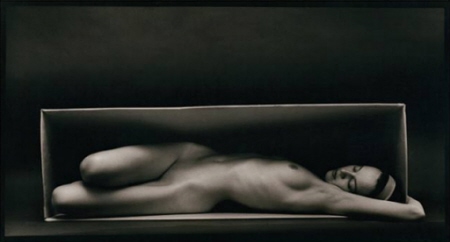The label below will be present in the exhibition alongside this piece. It is provided here so that fans submitting fanworks know in advance how fandom will be discussed in this project. However, fanworks do not need to take into account the below information and should be inspired by or responding to the piece of art alone:
Ruth Bernhard
American, 1905-2006
In the Box - Horizontal, 1962
Gelatin silver print
25 x 36 in
2009.11
Gift of the Estate of Ruth Bernhard
Photographer Ruth Bernhard moved from Germany to New York City in 1927, where she was heavily involved in the lesbian subculture of the artistic community. She is best known for black and white photographs of nude women that focus on minimalist forms and, in her words, “the little things that nobody observes, that nobody thinks are of any value.”
Like most of Bernhard’s work, In the Box - Horizontal focuses on the sensuality of the human body, yet it does more than simply represent that body. Through Bernhard’s mastery of light and line, she creates a sculptural, elegant form that forces the viewer to question their perceptions: does this piece showcase the female form, or does it turn a woman into an object to be viewed?
Identity
Identity is not just something we are; it is something we create and perform. Now more than ever we carefully curate our identities, both in person and especially online. Identifying yourself as a fan, either verbally or through visual markers such as clothing or other accessories, can imply a way of thinking about and engaging with the world at large, and may affect how an individual is perceived by others. Identifying as a member of a large, public fandom allows for the creation of an easily recognizable identity with little effort, while identifying with less obviously recognizable fandoms creates a safe environment to try on and experiment with various identities—including those that an individual may not be comfortable outwardly performing in their everyday lives.
Subscribe to RSS Feed (Opens in New Window)
| 2024 | ||
| Thursday, August 22nd | ||
| 12:00 AM |
Sweet Honey "In the Box - Horizontal" (identity) 12:00 AM - 12:00 AM |
|
|---|---|---|
| 12:00 AM |
plainblackcanvas56 "In the Box - Horizontal" (identity) 12:00 AM - 12:00 AM |
|
| 12:00 AM |
Holly Wood "In the Box - Horizontal" (identity) 12:00 AM - 12:00 AM |
|
| 12:00 AM |
Ennis Rook Bashe "In the Box - Horizontal" (identity) 12:00 AM - 12:00 AM |
|
| 12:00 AM |
Heatherly "In the Box - Horizontal" (identity) 12:00 AM - 12:00 AM |
|
| 12:00 AM |
Linda "In the Box - Horizontal" (identity) 12:00 AM - 12:00 AM |
|
| 12:00 AM |
Rileyspork/Jean Drzyzgula "In the Box - Horizontal" (identity) 12:00 AM - 12:00 AM |
|
